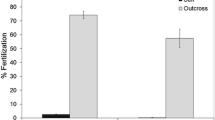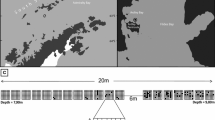Abstract
In marine invertebrate taxa with restricted larval dispersal, the movement of fertilizing sperm may contribute significantly to gene flow. Several recent studies have examined the ability of isolated males to fertilize eggs as a function of distance, but none has explicitly considered the effect of other males in the vicinity on the spatial distribution of fertilizations obtained by a male. I assayed the effect of additional males on the fertilization success of male Botryllus schlosseri (Pallas) colonies with respect to distance via an in situ mating experiment performed in Maine, USA during the summer of 1993. Allozyme markers were used to assay paternity. The presence of additional males reduced the ability of a focal male to fertilize eggs in all distance classes. This suggests that competition for fertilizations among males will reduce gene flow via sperm dispersal and that the fertilization success of isolated males may over-estimate gene flow via sperm dispersal in many natural populations.
Similar content being viewed by others
References
Babcock RC, Mundy CN (1992) Reproductive biology, spawning and field fertilization rates of Acanthaster planci. Aust J mar Freshwat Res 43:525–534
Benzie JAH, Black KP, Moran PJ, Dixon P (1994) Small-scale dispersion of eggs and sperm of the Crown-of-Thorns starfish (Acanthaster planci) in a shallow coral reef habitat. Biol Bull mar biol Lab, Woods Hole 186:153–167
Brazeau DA, Lasker HR (1992) Reproductive success in a marine benthic invertebrate, the Caribbean octocoral Briareum asbestinum. Mar Biol 114:157–163
Denny MW (1988) Biology and the mechanics of the wave-swept environment. Princeton University Press, Princeton
Denny MW, Shibata MF (1990) Consequences of surf-zone turbulence for settlement and external fertilization. Amer Nat 134:859–889
Gosner KL (1971) Guide to the identification of marine and estuarine invertebrates: Cape Hatteras to the Bay of Fundy. John Wiley and Sons, New York
Grosberg RK (1987) Limited dispersal and proximity-dependent mating success in the colonial ascidian Botryllus schlosseri. Evolution 41:372–384
Grosberg RK (1991) Sperm-mediated gene flow and the genetic structure of a population of the colonial ascidian Botryllus schlosseri. Evolution 45:130–142
Jackson JBC (1986) Modes of dispersal of clonal benthic invertebrates: consequences for species' distributions and genetic structure of local populations. Bull mar Sci 39:588–606
Levitan DR (1991) Influence of body size and population density on fertilization success and reproductive output in a free-spawning invertebrate. Biol Bull mar biol Lab, Woods Hole 181:261–268
Levitan DR, Sewell MA, Chia F (1992) How distribution and abundance influences fertilization success in the sea urchin Strongylocentrotus franciscanus. Ecology 73:248–254
Milkman R (1967) Genetic and developmental studies on Botryllus schlosseri. Biol Bull mar biol Lab, Woods Hole 132:229–243
Pennington JT (1985) The ecology of fertilization of echinoid eggs: the consequences of sperm dilution, adult aggregation, and synchronous spawning. Biol Bull mar biol Lab, Woods Hole 169:417–430
Petersen CW (1991) Sex allocation in hermaphroditic sea basses. Am Nat 138:650–667
Sabbadin A (1982) Formal genetics of ascidians. Am Zool 22: 765–773
Scheltema RS (1968) Dispersal of larvae by equatorial currents and its importance to the zoogeography of shoal-water species. Nature, Lond 217:1159–1161
Scheltema RS (1971) Larval dispersal as a means of genetic exchange between geographically separated populations of shallow-water benthic marine gastropods. Biol Bull mar biol Lab, Woods Hole 140:284–322
Scofield VL, Schlumpberger JM, West LA, Weissman IL (1982) Protochordate allorecognition is controlled by a MHC-like gene system. Nature, Lond 295:499–502
Williams GC (1975) Sex and evolution. Princeton University Press, Princeton
Yund PO (1990) An in situ measurement of sperm dispersal in a colonial marine hydroid. J exp Zool 253:102–106
Yund PO, McCartney MA (1994) Male reproductive success in sessile invertebrates: competition for fertilizations. Ecology 75:2151–2167
Author information
Authors and Affiliations
Additional information
Communicated by J.P. Grassle, New Brunswick
Rights and permissions
About this article
Cite this article
Yund, P.O. Gene flow via the dispersal of fertilizing sperm in a colonial ascidian (Botryllus schlosseri): the effect of male density. Marine Biology 122, 649–654 (1995). https://doi.org/10.1007/BF00350686
Received:
Accepted:
Issue Date:
DOI: https://doi.org/10.1007/BF00350686




